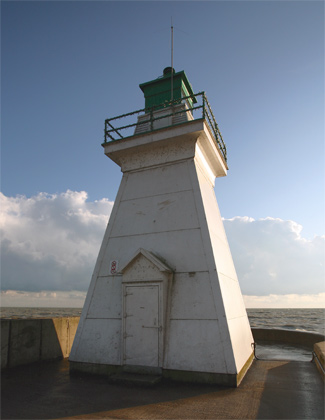Port Dover West Pier Lighthouse
Heritage Lighthouse
Port Dover, Ontario

General view
(© Kraig Anderson - lighthousefriends.com)
Address :
Harbour Street, Port Dover, Ontario
Recognition Statute:
Heritage Lighthouse Protection Act (S.C. 2008, c 16)
Designation Date:
2014-11-02
Dates:
-
1850 to 1850
(Construction)
-
1846 to 1846
(Established)
Description of Historic Place
The Port Dover West Pier Lighthouse is prominently located at the end of the west pier at the entrance to Port Dover Harbour, on Lake Erie. The lighthouse consists of an 8.6 metres (28 feet) square tapered wood-frame tower and square lantern. A foghorn protrudes from its south face. The lighthouse was originally used as a range light and later moved 18.3 metres (60 feet) from the middle to the end of the pier to serve as a harbour light.
Heritage Value
The Port Dover West Pier Lighthouse is a heritage lighthouse because of its historical, architectural, and community values.
The Port Dover West Pier Lighthouse is a very good example of Canada’s early expansion of the lighthouse system to improve navigation on the Great Lakes-St. Lawrence route in competition with the American Erie Canal. The first lighthouse on the site, built around 1846, was destroyed by fire and the existing lighthouse on the west pier was subsequently built around 1850.
The village of Port Dover developed around 1835 at the juncture of the Lynn River and Lake Erie, and it soon became an important port for the north-south trade route as well as the east-west St. Lawrence system. Simultaneously, Port Dover became a center for shipbuilding as well as the budding fishing industry. Port Dover continues to serve the commercial fishing industry as well as recreational fishers and boaters, and its wharf and associated lighthouse remain vital.
Architectural values
The design of the Port Dover Port Dover West Pier Lighthouse is a very good example of the wooden square-tapered design. The design is well-suited for maritime conditions and was used frequently for harbours and river routes. Square, tapered, wooden lighthouses were economical to build, using materials readily available in nearby forests and mills, and relying on local labour. They are durable and are able to withstand heavy winds due to their low centre of gravity. They were also relatively easy to move and the towers were adaptable to new applications, two features that are specifically reflected in the Port Dover West Pier Lighthouse.
Community values
The Port Dover West Pier Lighthouse reinforces Port Dover’s maritime character, and is visible from the shore and surrounding water. The lighthouse is the dominant structure on the pier.
The Port Dover West Pier Lighthouse has been, almost since its construction, an emblem of Port Dover’s maritime character and dependence on Lake Erie. The lighthouse continues to guide recreational and commercial vessels safely into the harbour. It has an extremely high landmark value for Port Dover and is a recognized symbol of the community. It is also an important tourist attraction for Port Dover, which is popular for summer vacations.
Related buildings
No related buildings are included in the designation.
Character-Defining Elements
The following character-defining elements of the Port Dover West Pier Lighthouse should be respected:
— its location at the end of the Port Dover west pier on Lake Erie;
— its current form and proportions, based on a standard design of square, tapered, wooden towers;
— its square wooden frame structure with tapered sides rising from a square base;
— its pedimented door;
— its gallery, supported by the flared cornice that transitions from the tapered walls;
— the design and material of the railing that surrounds the gallery;
— its square lantern with pyramidal roof and vent;
— the foghorn attached to the south face;
— its exterior colour scheme, consisting of white for the tower and cornice, and green for the lantern and the gallery railing and;
— its visual prominence in relation to the water and landscape.